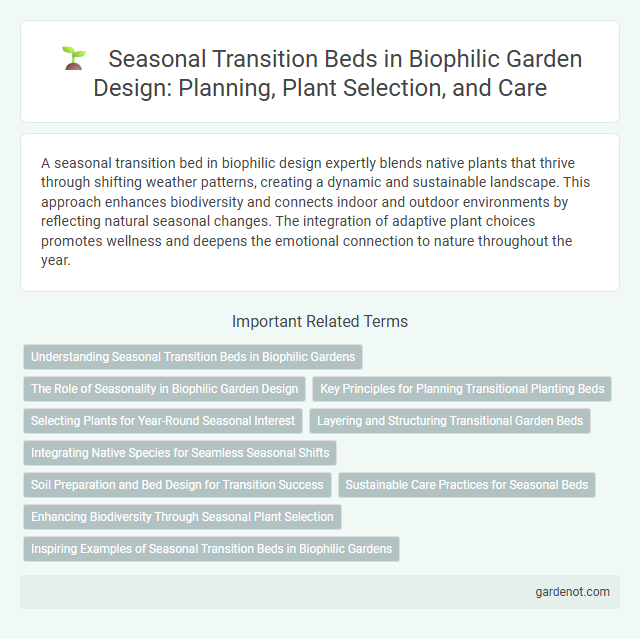A seasonal transition bed in biophilic design expertly blends native plants that thrive through shifting weather patterns, creating a dynamic and sustainable landscape. This approach enhances biodiversity and connects indoor and outdoor environments by reflecting natural seasonal changes. The integration of adaptive plant choices promotes wellness and deepens the emotional connection to nature throughout the year.
Understanding Seasonal Transition Beds in Biophilic Gardens
Seasonal transition beds in biophilic gardens strategically incorporate a diverse range of native plants to reflect and celebrate the changing seasons, enhancing ecological connectivity and supporting local biodiversity. These beds use a mix of perennials, bulbs, and shrubs that bloom or display unique foliage at different times, encouraging continuous sensory engagement and natural rhythm awareness for garden visitors. Integrating seasonal transition beds promotes sustainability by mimicking natural plant succession and providing habitats for pollinators throughout the year.
The Role of Seasonality in Biophilic Garden Design
Seasonal transition beds play a crucial role in biophilic garden design by enhancing biodiversity and creating dynamic landscapes that reflect natural cycles. Incorporating plants with staggered blooming periods and varied foliage colors supports ecological balance and promotes a sense of connection to nature. Thoughtful selection of native species ensures resilience and seasonal interest, fostering continuous engagement with the environment throughout the year.
Key Principles for Planning Transitional Planting Beds
Seasonal transition beds emphasize layering diverse plant species with varying bloom times to ensure continuous visual interest and ecological support throughout the year. Prioritize native perennials, grasses, and bulbs coordinated to provide sequential flowering and foliage color changes, enhancing biodiversity and habitat connectivity. Strategic spacing and soil preparation optimize plant health and resilience, aligning with biophilic principles to create restorative, nature-integrated spaces.
Selecting Plants for Year-Round Seasonal Interest
Choosing plants that thrive through seasonal transitions is essential for a successful seasonal transition bed, incorporating evergreen shrubs, deciduous perennials, and early-blooming bulbs to maintain visual interest throughout the year. Incorporate native species such as hellebores for winter appeal, ornamental grasses for autumn texture, and flowering perennials like coneflowers for summer vibrancy to ensure ecological compatibility and year-round resilience. Strategic layering and varied plant heights enhance the biophilic design by creating dynamic, evolving landscapes that connect occupants with nature's seasonal cycles.
Layering and Structuring Transitional Garden Beds
Layering and structuring transitional garden beds in biophilic design enhance seasonal transitions by creating dynamic plant arrangements that reflect changing natural cycles. Incorporating diverse plant heights, textures, and bloom times builds depth and visual interest while supporting biodiversity. This approach fosters a seamless connection between indoor and outdoor environments, promoting wellbeing through nature-inspired rhythms.
Integrating Native Species for Seamless Seasonal Shifts
Integrating native plant species in a seasonal transition bed enhances biophilic design by promoting ecological balance and natural resilience. These species support local wildlife and adapt effortlessly to seasonal changes, reducing maintenance and fostering a seamless visual transition. Incorporating native flora creates a habitat that evolves throughout the year, strengthening the connection between indoor and outdoor environments.
Soil Preparation and Bed Design for Transition Success
Soil preparation for a Seasonal Transition Bed involves enriching the soil with organic matter such as compost and well-rotted manure to enhance nutrient retention and microbial activity essential for plant acclimatization. Incorporating raised bed design with proper drainage and soil aeration ensures root health during fluctuating temperatures common in seasonal changes. Strategic layering with mulch and soil amendments maintains moisture balance and supports seamless plant transitions aligned with biophilic design principles.
Sustainable Care Practices for Seasonal Beds
Seasonal transition beds utilize drought-resistant native plants and organic mulches to promote sustainable care practices, reducing water consumption and minimizing chemical fertilizer use. Incorporating compost-rich soil enhances plant resilience during seasonal shifts, supporting soil health and biodiversity. Strategic placement of shade-tolerant species further conserves moisture and reduces maintenance needs throughout changing seasons.
Enhancing Biodiversity Through Seasonal Plant Selection
Seasonal transition beds enhance biodiversity by incorporating a diverse array of native plants that thrive during different times of the year, supporting a wide range of pollinators and wildlife. Selecting species with staggered blooming periods ensures continuous habitat and food sources, fostering ecosystem resilience within urban and residential spaces. This approach not only promotes ecological balance but also creates visually dynamic landscapes that evolve with seasonal changes.
Inspiring Examples of Seasonal Transition Beds in Biophilic Gardens
Seasonal transition beds in biophilic gardens showcase dynamic plant arrangements that change with the seasons, enhancing sensory engagement and ecological diversity. Featuring native perennials, ornamental grasses, and early-blooming bulbs, these beds provide continuous visual interest and habitat support for pollinators. Notable examples include the seasonal transition beds at the New York Botanical Garden's Native Plant Garden and the Chicago Botanic Garden's Fall Woodland Collection.
Seasonal transition bed Infographic

 gardenot.com
gardenot.com